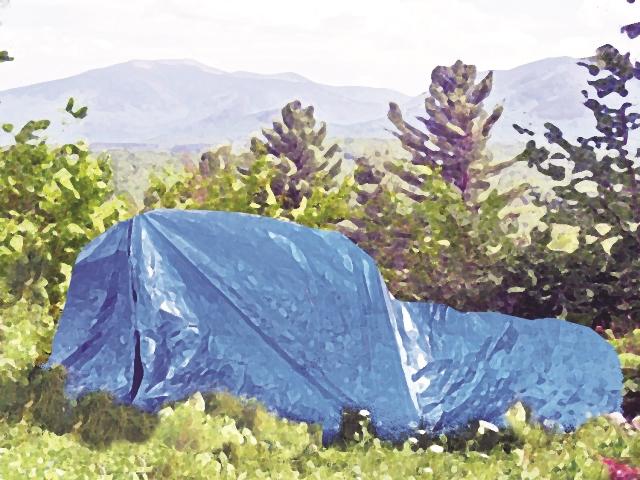Blue Tarps as Art

"A Few Parts Short of a Classic - Under Blue Tarp," photo illustration by Tom Lynch / Union Leader.
Traveling in the Midwest this past week, I was introduced to a local as being from New Hampshire.
“Oh, New Hampshire,” she gushed, “it’s sooooo beautiful there. When I think of New Hampshire, I think ‘pristine’.”
She went on to tell me about trips she and her family had made to New Hampshire’s lakes and mountains that formed her perception My first thought was to my house, where ‘pristine’ is not a word many would use to describe the farmyard in any given April. I do try to keep things neat and aesthetically pleasing. Inspired by the artist Christo, who is known for wrapping buildings and bridges and even whole islands, each fall I decorate the yard with objects wrapped in my favorite artistic medium, the Blue Tarp.
Alas, my work has not yet been discovered by a big-city art dealer, despite the fact that I pose dramatically amidst my oeuvre every time I spy a car with New York plates coming up the road. But one of these days a foresighted dealer, on the prowl for undiscovered rustic talent with an impressive body of work, will pull his or her Beemer into my dirt driveway.
One discerning look at my 2004 piece, “Rusty Parts from Machinery I No Longer Own, Swaddled in Blue Tarp”, will make me an art-world star. I will be acclaimed for the contrasting colors of my bungee cords, the delicate wind-blown fraying of my tarp edges, and my clever use of baling twine. Within weeks, a gallery in Soho will be selling even my minor works, like “Fence Made of Old Pallets,” for six figures, despite an influential art reviewer’s complaint that it seems ‘derivative’.
I will refuse to sell one of my earliest pieces, “Boat with Ripped Cover on Trailer with Broken Axle,” because I’m pretty sure it’s permanently stuck in the mud. Besides, I’m going to get around to fixing up that boat one of these days because it’s kind of a classic.
But the high-falutin aesthetics of a New Hampshire farmyard, I suspect, are not what this new acquaintance meant when she called New Hampshire ‘pristine’. It is our unbuilt infrastructure, our mountains and valleys, streams and ponds, forests and fields, clear air and clear water, that combined to leave her with that impression.
So my second thought was, wow, that’s a great identity for our state. And how gratifying that it’s an identity formed by a few visits rather than an advertising campaign. We certainly have heavily developed parts of our state, but what draws people here, what they remember once they leave, is ‘pristine.'
Which led me to my third thought, which is two more than I usually have on any given day: are we adequately protecting our ‘pristine’ brand? Will a visitor in five years or 10 years come away from New Hampshire with that same impression? Today, out-of-state interests continue to push to build more things that have little to do with New Hampshire at a cost to our brand. If we allow them to not just nibble, but gnash away at our natural surroundings and natural resources, we may well find ourselves indistinguishable from the suburbanized communities that dominate other states.
The good news is that there are an increasing number of people working to protect the pristine. On Saturday, hundreds of people committed to land conservation gathered in Alton for the Saving Special Places conference to learn about the evolving ways we can endeavor to, well, save New Hampshire’s special places. As a highlight, Paul Bofinger (past president/forester of the Society for the Protection of New Hampshire Forests) and long-time environmental champion Sharon Francis discussed the work they have done to leave us with what we have today.
And today, I think we can argue that we are in many places (other than my farmyard) still ‘pristine.' Whether we can still say that in the near future is up to all of us.
Jack Savage is the Executive Editor of Forest Notes magazine published quarterly by the Society for the Protection of New Hampshire Forests. He can be reached by email at jsavage@forestsociety.org, or follow him on Twitter @JackAtSPNHF.
